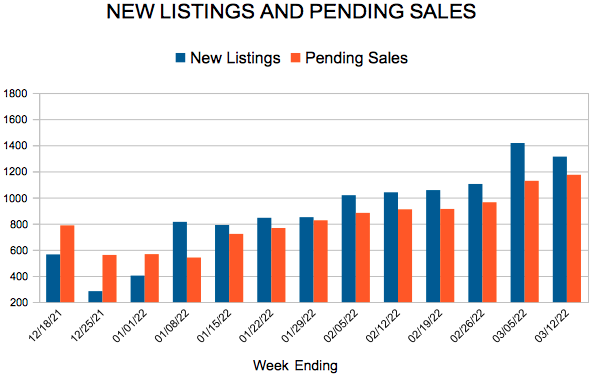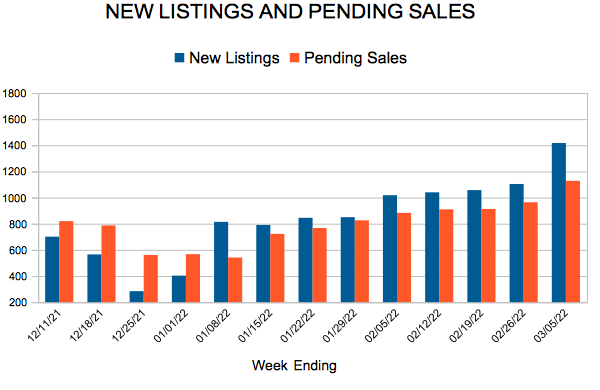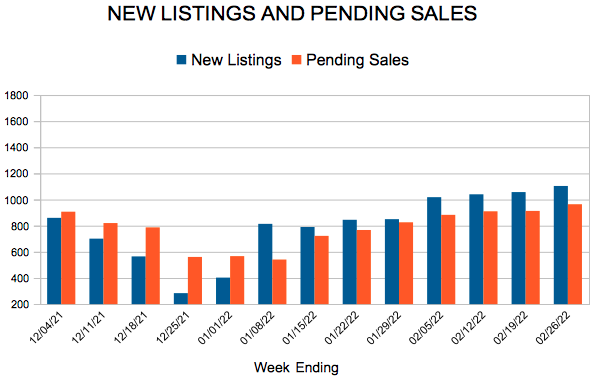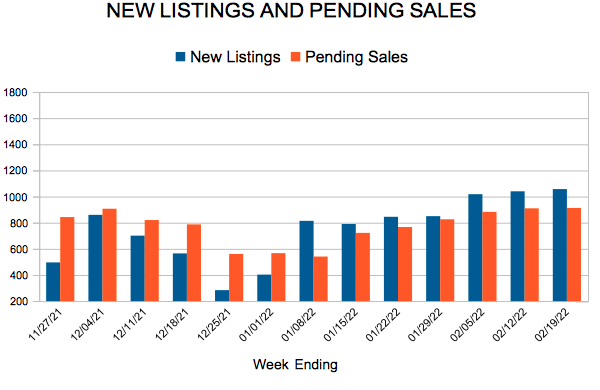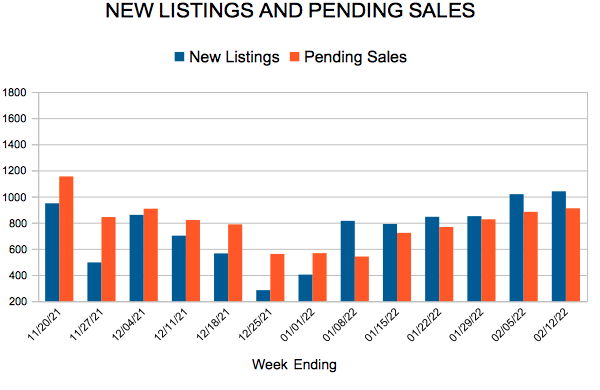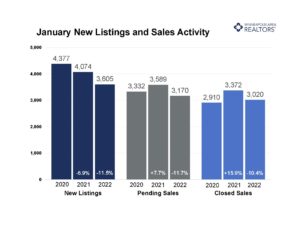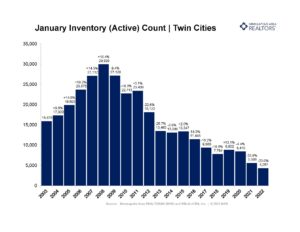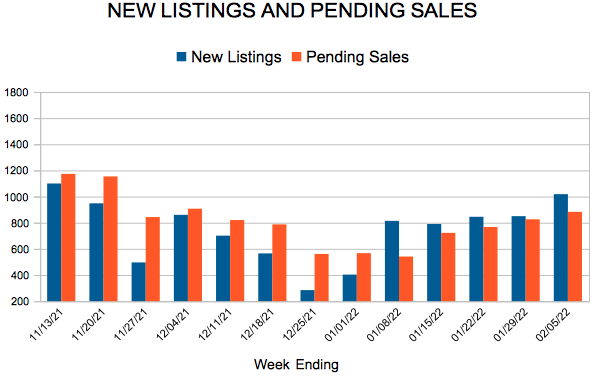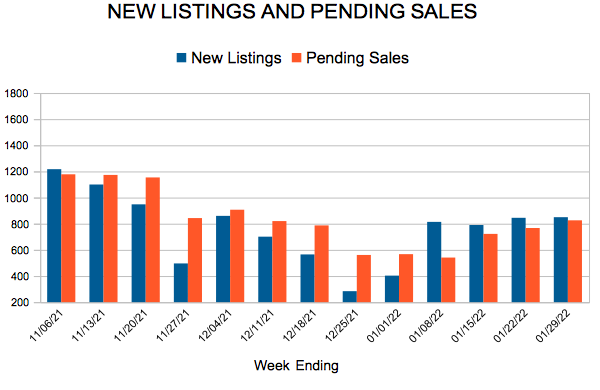Sales begin seasonal upswing, but down from last two unusually strong Februarys
- Twin Cities saw 3,809 signed purchase agreements, down 10.5 percent from February 2021 but above 2019 levels
- The number of homes for sale at month-end fell 19.0 percent from last year
- Median Sales Price rose 8.3 percent to $340,000
(March 15, 2022) – According to new data from Minneapolis Area REALTORS® and the Saint Paul Area Association of REALTORS®, buyer activity in the Twin Cities metro showed its first month-over-month gain since August 2021. As the Covid reshuffle continues to temper, sales are down compared to February of 2020 and 2021, but up from 2019 levels.
LISTINGS & SALES
Buyers signed 10.5 percent fewer purchase agreements than last year and closed on 15.3 percent fewer homes. Since 2020, seller activity has remained especially sluggish—the 4,427 new listings are 18.2 percent fewer than February 2020. While the seasonal uptick toward spring market has begun, it may prove challenging to match activity levels from the prior two years, as the pandemic and the prospect of rising rates shifted activity up from 2022 and 2023 into 2020 and 2021 to accommodate working and learning from home.
“Homes sold more quickly last month than they did last February, and prices rose over 8.0 percent,” said Denise Mazone, President of Minneapolis Area REALTORS®. “While we may not reach the heights of 2020 and 2021, the market remains competitive, homes are still selling rapidly often with multiple bids, and buyers and sellers need to be prepared to move quickly.” Market times have been falling for years, but today’s listings spend even less time on the market. Two years ago, half of the listings went under contract in under 40 days, but last month, half of the listings spent fewer than 19 days on the market. That’s more than a 52.0 percent drop.
HOME PRICES & INVENTORY
The median sales price in the Twin Cities rose 8.3 percent from last February to $340,000. That’s exactly half the 16.6 percent year-over-year rate of price growth seen in May 2021. Rising prices are expected to continue in a persistently undersupplied market with historically strong demand. The Twin Cities presently has about three week’s supply of inventory (0.8 months), where a balanced market would supply four to six months’ worth of homes given recent demand.
Inventory levels dipped 19.0 percent from this time last year. Compounded with a 38.2 percent fall from 2020 to 2021, the metro is facing an inventory shortage that should keep prices strong, market times fast, multiple offers fairly commonplace and some sellers getting above asking price. “Homeowners have gained significant equity, particularly over the last few years,” according to Mark Mason, President of the Saint Paul Area Association of REALTORS®. “Having a knowledgeable advisor to navigate a fast and complex process can help buyers be more competitive and successful.”
LOCATION & PROPERTY TYPE
Market activity varies by area, price point and property type. New construction sales fell 15.5 percent compared to only a 12.2 percent dip in sales of previously owned homes. Single family sales tumbled 9.8 percent while condo sales were down an even 10.0 percent. Between Minneapolis and St. Paul, the latter took the harder hit in sales losses. Saint Paul’s sales were 24.8 percent down compared to Minneapolis’ loss of 15.1 percent. Hastings, Delano and Rush City all had more than double the sales from last year while Hugo, Little Canada and East Bloomington weren’t far behind. Sales fell by around 50.0 percent in Prior Lake, New Hope, Big Lake and Golden Valley.
February 2022 by the numbers compared to a year ago
- Sellers listed 4,427 properties on the market, a 7.3 percent decrease from last February
- Buyers signed 3,809 purchase agreements, down 10.5 percent (2,769 closed sales, down 15.3 percent)
- Inventory levels fell 19.0 percent to 4,361 units
- Month’s Supply of Inventory was down 20.0 percent to 0.8 months (4-6 months is balanced)
- The Median Sales Price rose 8.3 percent to $340,000
- Days on Market fell 8.7 percent to 42 days, on average (median of 19 days, down 5.0 percent from February 2021)
- Changes in Sales activity varied by market segment
- Condo sales fell 16.0 percent, single family sales fell 14.8 percent & townhouse sales fell 4.6 percent
- Traditional sales were down 12.6 percent; foreclosure sales were down 44.4 percent; short sales fell 100.0 percent
- Previously owned sales dropped 12.6 percent; new construction sales decreased by 15.9 percent
February 2022 housing charts
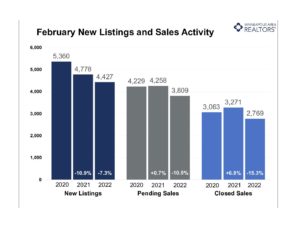
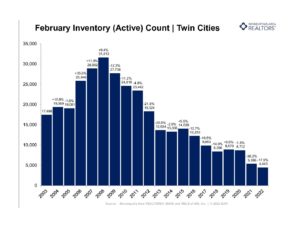
From The Skinny Blog.
New Listings and Pending Sales
New Listings and Pending Sales
New Listings and Pending Sales
New Listings and Pending Sales
Twin Cities Housing Market Starts off the Year Slowly, For Now
- Metro-wide Inventory is down 24.2 percent since the start of 2021
- Month’s Supply of Inventory (absorption rate) is at a record low, ~ 3 weeks of supply
- Median Sales Price rose 10.4 percent to $332,250
(February 15, 2022) – According to new data from Minneapolis Area REALTORS® and the Saint Paul Area Association of REALTORS®, inventory levels in the Twin Cities metropolitan area have reached a decades-long low of 4,221 homes at the end of January. At the current rate of demand, this inventory would last little more than three weeks without the addition of new listings. The market would require six months of supply in order to be considered balanced.
LISTINGS & SALES
Real estate in the Twin Cities saw a peak of buyer activity throughout 2021, but only now are we able to see the extent of that increased demand. Year over year comparisons of pending sales indicate a noticeable drop of 11.7 percent from last January, but a more historical perspective shows that the 3,170 purchase agreements signed last month are comparable to January of 2019 and 2018. Closed sales show a similar picture, 2022 is not starting off with the same fervor as 2021. The same goes for sellers, resulting in an 11.5 percent drop in supply since last January.
“The year began about as expected, with both sales and listings unable to match their year-ago levels,” said Denise Mazone, President of Minneapolis Area REALTORS®. “But don’t get the wrong idea, the market is expected to remain pretty hot this year as demand continues to outpace supply but also as buyers hope to get ahead of rising rates.”
INVENTORY
While the supply of new listings has historically been a concern for over a decade, the public could usually count on consistent year-over-year activity from sellers until 2020. A sharp fall in supply two summers ago followed by a rebound in 2021 led to variations in seller activity unseen since 2015. Last month sellers listed 3,605 properties on the market, our lowest level of seller activity since 2005.
“It’s important that market participants understand what less than 1.0 month of supply means,” according to Mark Mason, President of the Saint Paul Area Association of REALTORS®. “This means well-priced and attractive listings will sell quickly and often with multiple offers in play. Buyers should be patient but prepared to write strong, non-contingent offers while sellers should be ready to move quickly.”
HOME PRICES
The stark contrast between lackluster seller activity and the remaining rush of demand from buyers leaves the Twin Cities with a housing market where half of its listings last no longer than 21 days, down 4.5 percent from a year prior. This strong seller’s market has driven up the price of listings, now at $332,250 which is the highest January median sales price on record. These market dynamics, if left unchanged, show signs of high market prices and stiff competition for buyers as the weather warms.
LOCATION & PROPERTY TYPE
Market activity varies by area, price point and property type. The condominium market has seen a significant increase in the past year, yet January was the first significant drop in the number of condo sales, down 11.5 percent. New construction has hit a downward trend since last summer and this trend continues with a 6.8 percent decrease in sales. Between Minneapolis and St. Paul, the state capitol city fared better for the first month of the year, seeing a 2.3 percent increase in closed sales while Minneapolis experienced a 16.1 percent drop in sales. The suburban cities that showed the most sales growth in January were Savage (100 percent), Chanhassen (50.0 percent), and Stillwater (45.5 percent) while those that lost the most sales from last year were West Bloomington (- 43.9 percent), Lakeville (- 43.0 percent), and St. Louis Park (- 41.7 percent).
January 2022 by the numbers compared to a year ago
-
- Sellers listed 3,605 properties on the market, an 11.5 percent decrease from last January
- Buyers signed 3,170 purchase agreements, down 11.7 percent (3,020 closed sales, down 10.4 percent)
- Inventory levels fell 24.2 percent to 4,221 units at month-end
- Months Supply of Inventory was down 20.0 percent to 0.8 months (4-6 months is balanced)
- The Median Sales Price rose 10.4 percent to $332,250
- Days on Market fell 2.4 percent to 41 days, on average (median of 21 days, down 4.5 percent from January 2021)
- Changes in Sales activity varied by market segment
- Single family sales fell 11.0 percent; Condo sales declined 11.5 percent & townhouse sales were down 4.5 percent
- Traditional sales decreased 9.3 percent; foreclosure sales tumbled 32.4 percent; short sales fell 69.2 percent
- Previously owned sales were 9.9 percent lower; new construction sales were 6.8 percent lower
January 2022 housing charts
New Listings and Pending Sales
New Listings and Pending Sales
New Listings and Pending Sales
- « Previous Page
- 1
- …
- 12
- 13
- 14
- 15
- 16
- …
- 22
- Next Page »

